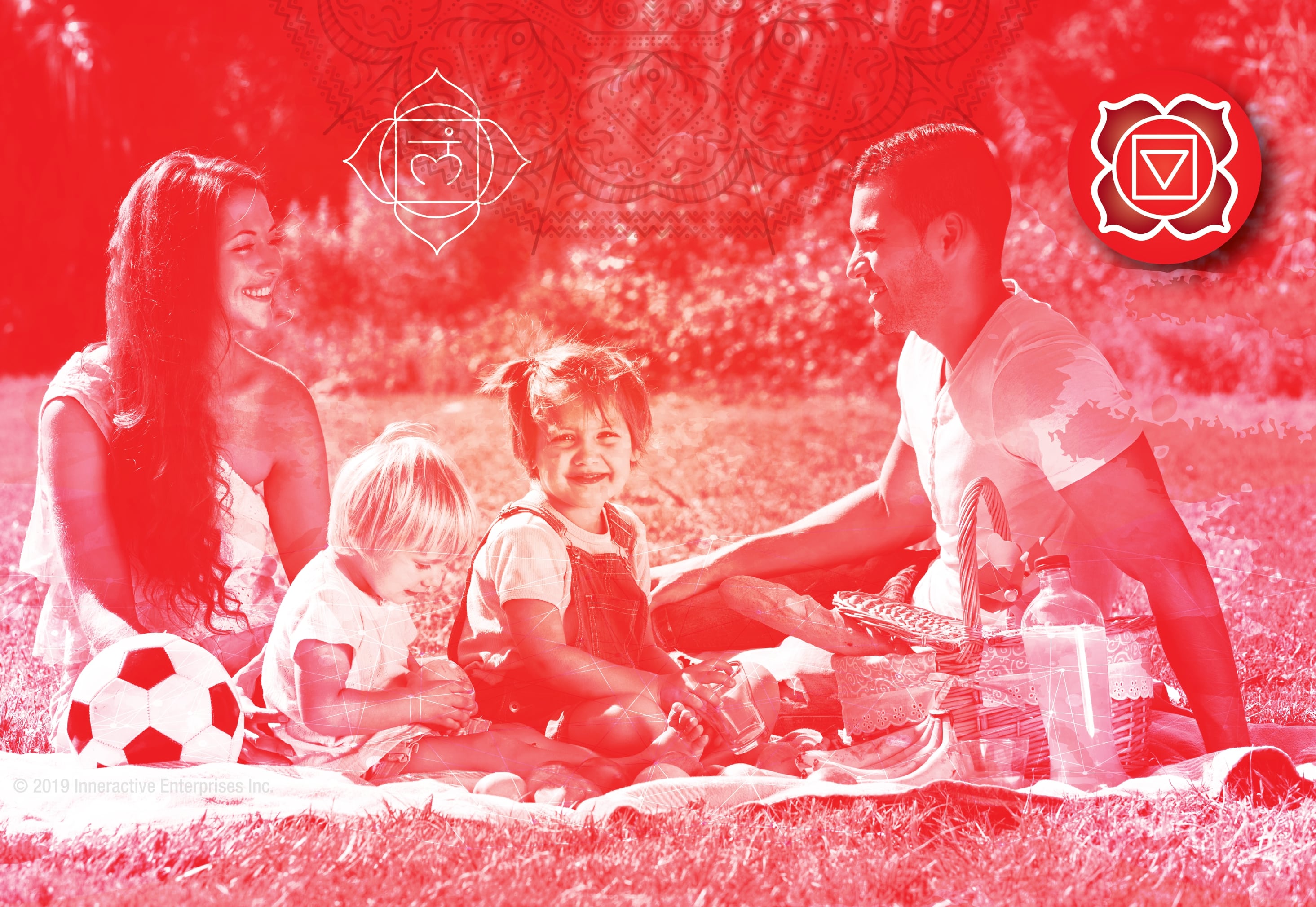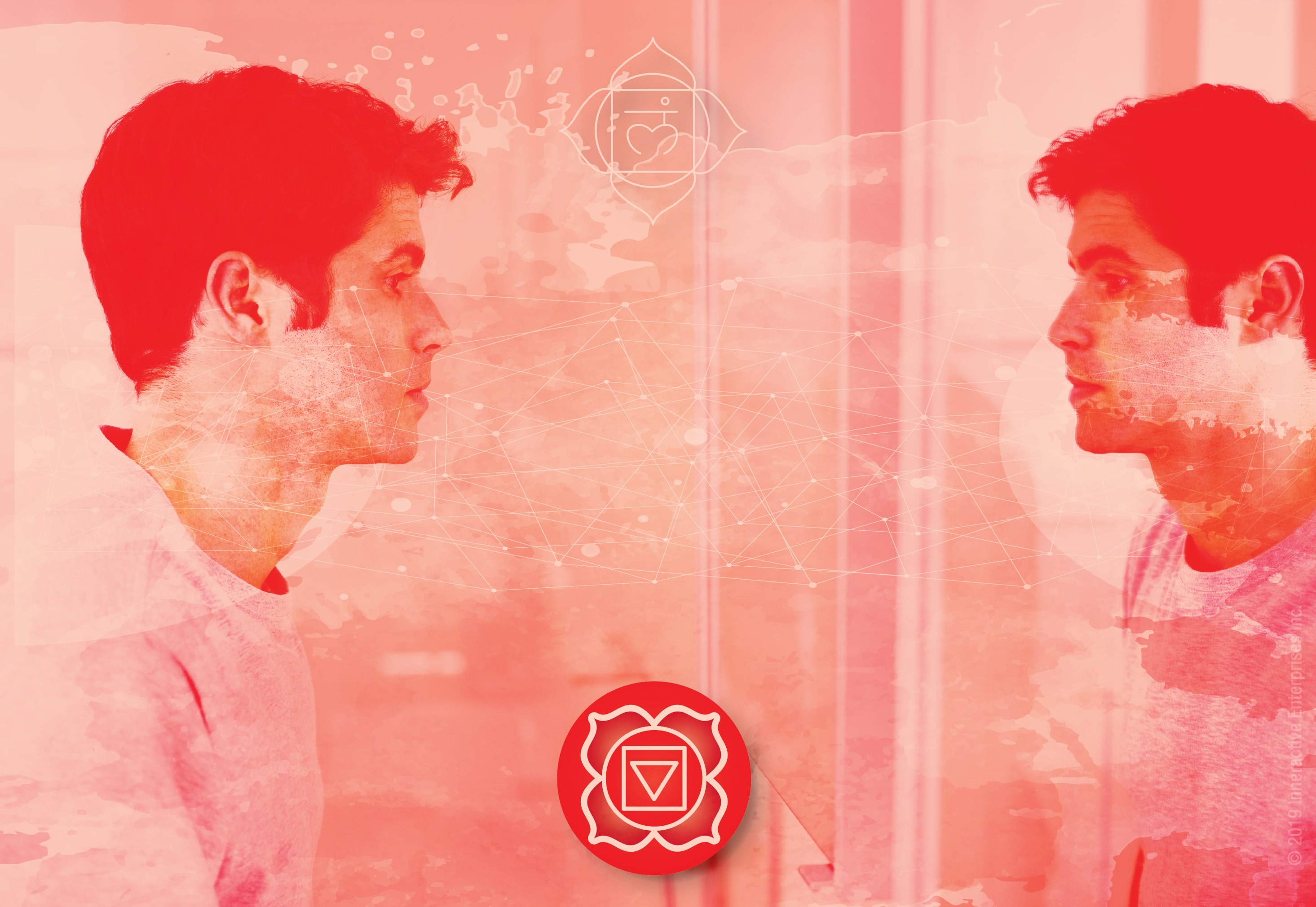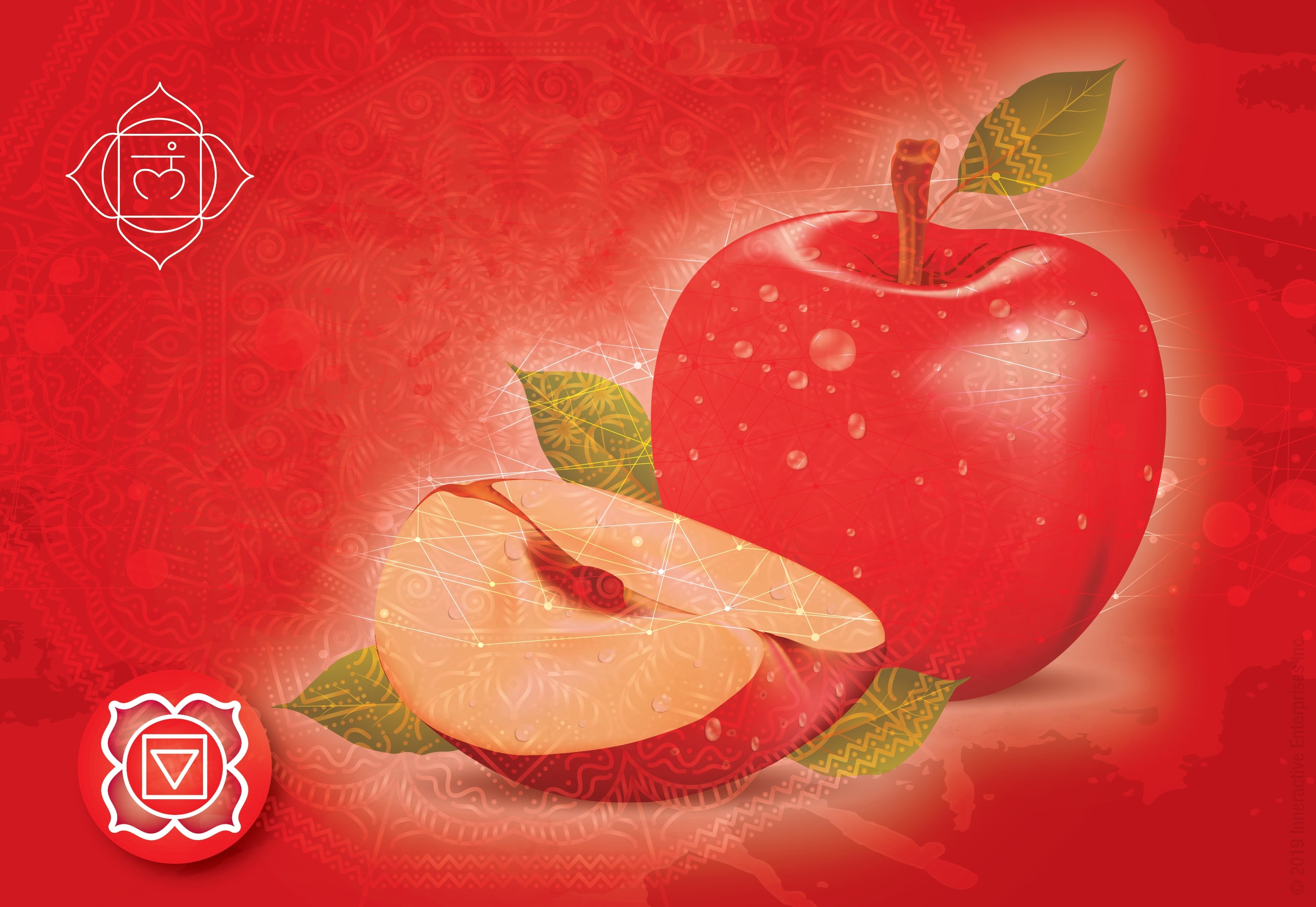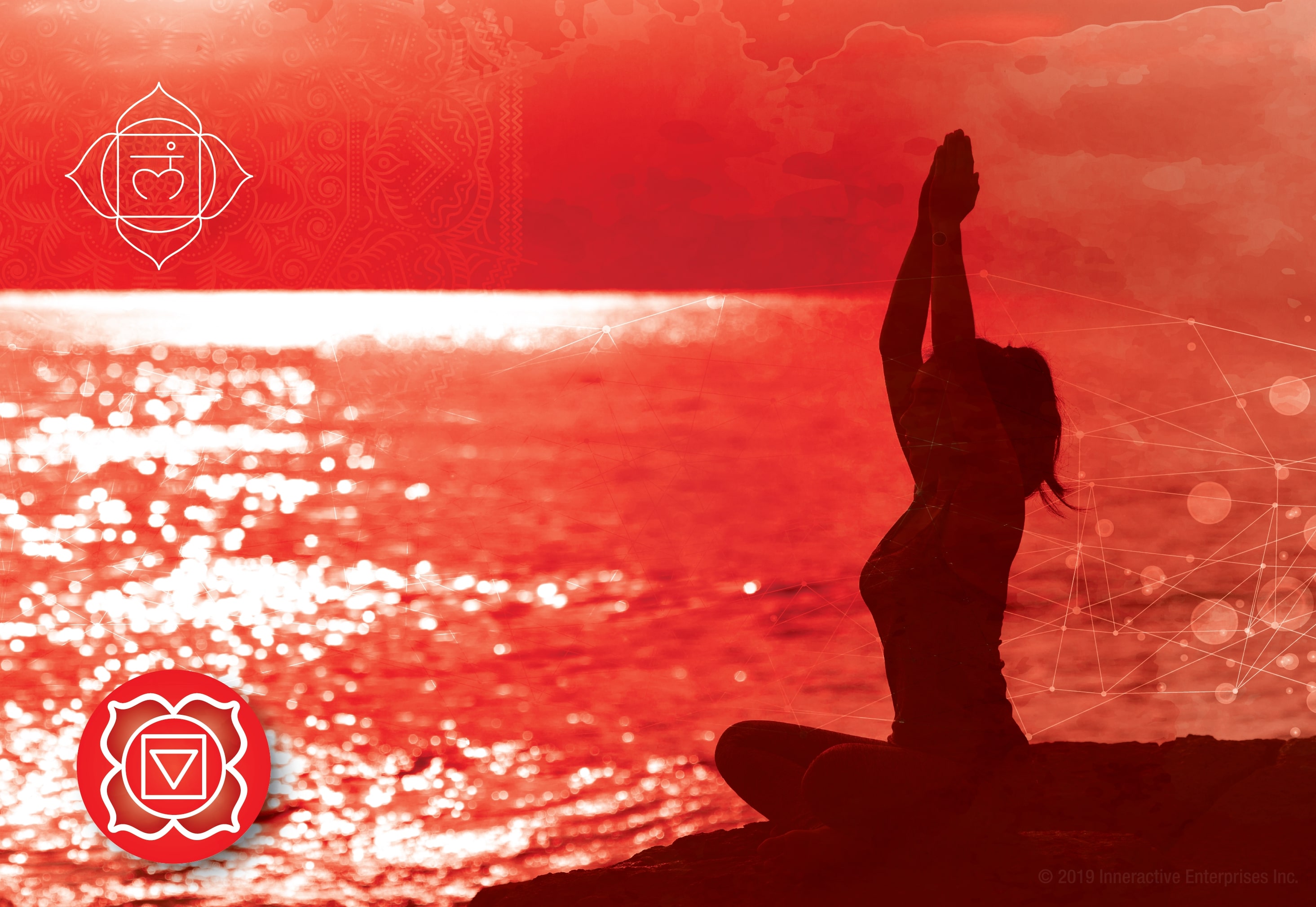
Chakras are considered to be different focal points of energy throughout the body—there are seven total. These chakras exist within all of us and may dictate a myriad of things, including our thoughts, habits, and patterns. But let’s start at the beginning with the first chakra, the Root Chakra.
Note: This article is written according to people’s belief in metaphysics.
Root Chakra Meaning
In the Hindu tradition, the root chakra, or Muladhara in Sanskrit, is the center of our emotional being. The Muladhara means “foundation” in Sanskrit and is represented by a red lotus flower with an inverted triangle.
The Muladhara helps guide and support us through life’s challenges and joys—keeping us feeling grounded and balanced. The root chakra is located at the bottom of the spine and radiates a warm, red flow of energy through the pelvic floor and into the first three vertebrae.

Considered to be our first chakra out of seven, we must start at the base of the chakras at the root, if you will, in order to understand its place as the foundation.
A little background: the chakras are thought to be deeply connected to unique aspects of our health; each one stabilizing or pivoting our sense of center depending on its health.
- Red – Root Chakra or Muladhara chakra.
- Orange – Sacral Chakra or Svadhisthana chakra.
- Yellow – Solar Plexus Chakra or Manipura chakra.
- Green – Heart Chakra or Anahata chakra.
- Blue – Throat Chakra or Vishuddha chakra.
- Indigo – Third Eye Chakra or Anja chakra.
- Violet – Crown Chakra or Sahaswara chakra.
The root chakra is considered our centering chakra – connected to our sense of security and stability. The root chakra’s balance depends on factors that make you feel at ease in your life, primarily focusing on your basic needs. Survival needs like food, water, shelter, financial stability, and safety all contribute to the harmony of your root chakra. If your life feels unstable in these areas, your root chakra may become unbalanced.

The root chakra is also said to be influenced by our social stability and whether or not we feel secure with the people around us. This is an important piece of our identity and may reflect our own balance and how we interact with others. The release of chakra energy others see is our aura, a kind of energy field that surrounds all living things. Chakras and auras are different but metaphysical thought suggests they are interconnected.
A stable, healthy root chakra can mean we feel safe and balanced. When we feel at ease with our foundational needs, we are able to be more present and in-tune with our other chakras.
Root Chakra Problems

Root chakra problems may be triggered by current sensations of instability in our lives, but are said to also be shaped by our early experiences as children. Insecurity can follow us throughout our lives and are often not easy to overcome. By understanding and working to heal your chakras, you may have greater mental clarity and balance.
Blocked or Imbalanced Root Chakras
When one of your chakras feels “off,” the entire system can be jeopardized as other chakras have to take on the responsibilities of the compromised chakra(s). Practicing chakra-balancing behaviors regularly is important for maintaining a healthy chakra system in adherence to spiritual traditions.
Chakras can be thrown off by conflict, change, anxieties, and uncertainty.
Root Chakra Imbalance Symptoms
When your root chakra becomes unbalanced, you may experience a sensation of uneasiness that can alter your presence and center.
Some metaphysicians say an imbalanced root chakra can also take form as an overactive root chakra. In some, this can look like an overabundance of energy – typically aggressive or agitated outward energy. Chakra wellness techniques work to balance both overactive and deficient chakras, so no matter what end of the spectrum you’re on, you may benefit from implementing healthy chakra practices.
Root Chakra Healing
Although you can have serious issues with your chakras and the energy affecting them, spiritual thinkers suggest you can fix them with different techniques and strategies.
Root chakra wellness begins with understanding the chakra system and recognizing how your body coexists with your seven chakras. By checking in with and tending to your body’s needs, you could feel improved clarity and stability through life’s constant changes.
Balancing Your Root Chakra Outside
The root chakra is said to be our first, and most primal chakra – closely related to our survival instincts and need to connect with nature. Spiritual individuals mention that making a connection with the earth by doing activities outside or simply soaking in a tranquil, sunny space can help to restore balance in your root chakra.

Here are some ways you can incorporate the outdoors to heal your root chakra:
- Take a hike: Explore a new or familiar trail, enjoy the fresh air and grounded feeling as your hiking boots connect with the earth.
- Touch the earth: Take a walk to feel the grass or dirt with your bare feet and establish a connection to natural material.
- Disconnect in a quiet outdoor space: quiet the constant connection by leaving your mobile device at home for a few hours while you embrace tranquility in nature.
- Go camping: Extend your wellness into a weekend trip. Embrace your natural ability to survive in nature and feel refreshed.
- Do yoga outside: Set up your mat in your yard or at the park and enjoy how different it feels to practice outside.
- Plant a garden: Feeling dirt with your bare hands and working outside gives us a sense of fulfillment and responsibility, help something grow as your chakras grow, too.
Balancing Your Chakra with Foods
Monitoring your diet could help your chakras feel more balanced. Red foods, rooted vegetables, foods with earthy flavors, and foods high in protein are ideal foods to balance your root chakra.

Foods for a balanced root chakra:
- Red apples
- Radishes
- Beets
- Lentils
- Carrots
- Garlic
- Ginger
- Pomegranate
- Earthy Broths
- Harvest Grains
Balancing your Chakra with Exercise
Staying active can help clear your mind of the clutter and stress of daily life, and may also help your chakra system to feel more balanced.
- Dance: Establish a connection to your body’s movement by expressing yourself through dance.
- Practice Yoga: Practice yoga poses that focus on grounding motions like Warrior One, Shavasana, Tadasana (Mountain Pose), and Triangle Pose.
- Run or Walk: Reduce your blood pressure and improve your cognitive function by going outside for a run or walk.
Root Chakra Meditation
Practicing root chakra meditation is another way people work to heal their root chakras. Taking time to focus on your energy through meditation may help spiritual individuals feel more grounded and safe.
You can incorporate sound, aromatherapy, and wellness crystals in your practice:
- Diffuse or apply essential oils with earth elements like Cedarwood, Patchouli, and Angelica Root
- Listen to or chant the mantra sound “LAM”
- Red stones like Bloodstone and Jasper can be placed on your root chakra area (pelvic area) as you meditate
Meditation is said to help balance the root chakra and for some, help them feel more connected with their seven chakras. Reaching a higher level of spirituality can balance and elevate our crown chakra.
Root Chakra Affirmations

Repeating daily affirmations is another way spiritual individuals reaffirm their safety and in turn, balance their chakras.
Here are some declarations that may help reassure yourself and may help rebalance your root chakra:
- I am enough.
- My home is safe and secure.
- I am supported by family and friends.
- I love my body.
- I am connected with the earth.
- I am safe.
- My needs are met.
- I have enough.
- I trust my decisions.
- I am at peace.
- I am in control.
- My future will be prosperous.
- I am at peace with my surroundings.
- I am financially secure.
- I am confident.
The root chakra is also said to be closely related to our sexuality. Working toward a balanced root chakra could mean a deeper connection with your partner and more fulfilling intimacy for both partners.
Try practicing these root chakra-grounding affirmations aloud on your own, or with your partner:
- I trust my partner.
- I am safe to express myself with my partner.
- I feel confident with my partner.
- I feel protected with my partner.
A healthy root chakra depends on a lifetime of security, safety, and fulfillment – so many people are likely to suffer from an imbalanced root chakra at some point. Constant changes, new jobs, financial challenges, and relationships could all have an impact on our root chakra health—and they’re often unavoidable aspects of life.
Practicing metaphysical chakra wellness and awareness exercises may help to achieve a more balanced root chakra. Once you’ve done some chakra healing, you may notice a substantial change in your connectedness to others and yourself. This may help you feel more assured to make big decisions and step outside of your comfort zone.
How do you know if your root chakra is healthy? Metaphysical teachings attribute these characteristics to a balanced root chakra:
- Sense of stability
- Drive to connect with others
- Less connection to materialistic objects
- Increased libido
- Mental clarity
- Desire to be active
- Healthy eating habits
Do what you can to balance your root chakra, and await the benefits it provides.







